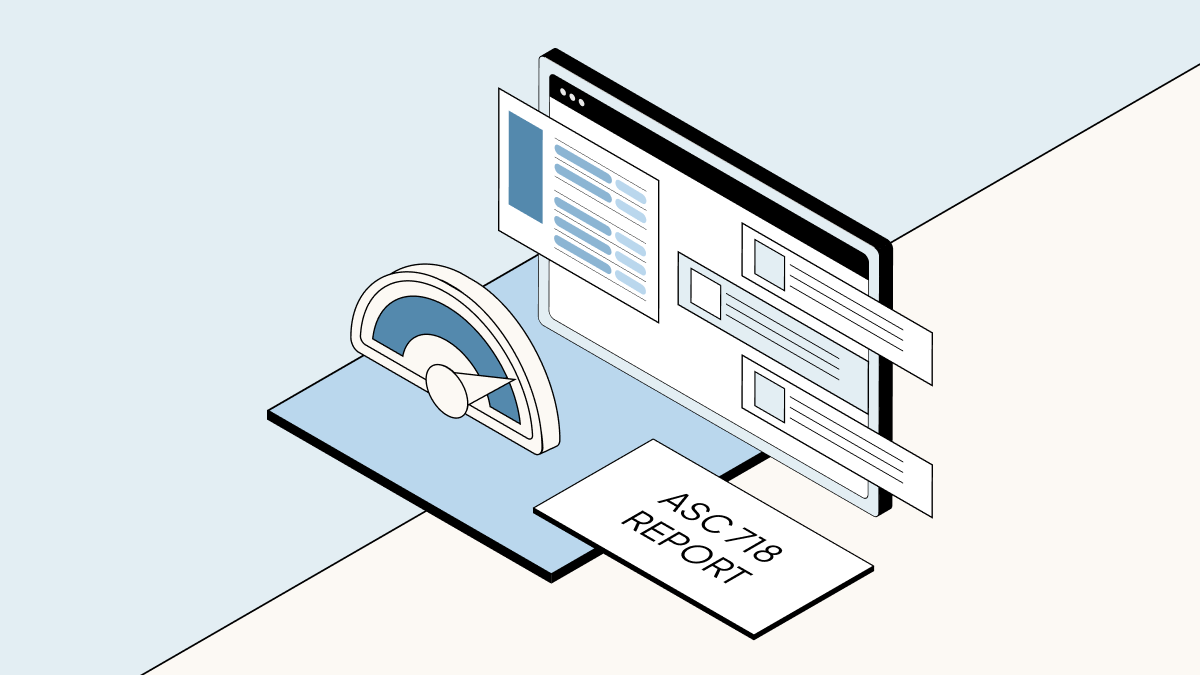What is ASC 718?
ASC 718 is the standard accounting guidance used by companies to “expense options,” or recognize the transfer of value involved in awarding stock options and other types of equity compensation to employees. Company stock or options may grow in value over time, so recording employee grants on your company’s income statement is important, especially as it grows.
Forms of employee compensation such as stock options and restricted stock units (RSU) for corporations and profits interest units (PIU) for LLCs are governed by a specific set of accounting rules. The Financial Accounting Standards Board (FASB) outlines these rules under the Accounting Standards Codification (ASC), Topic 718. Expense accounting used to be known as FAS 123(r), but now falls under ASC 718.
How to expense employee options under ASC 718
The ASC 718 guidelines include three basic steps for expensing employee-stock-based compensation:
-
Calculate the fair value of the equity compensation
-
Allocate the expense over the option’s useful economic life (more on that below)
-
Reflect compensation expenses on your income statement
Calculating the value of an option
This step gives you key information, such as how much the option grant is worth and how much to reflect on your income statement.
Because stock options and profits interest units are illiquid assets, their value can’t be determined on the open market; companies need to calculate how much they’re worth using a model. ASC 718 does not state a preference for the valuation model used, but it does list factors that a good model must include:
-
Expected term
-
Volatility
-
Interest rate
-
Dividend yield
-
Fair market value (FMV), calculated using a 409A valuation
Allocating the expense over the option’s useful economic life
Once you’ve calculated the fair value of the equity, it’s time to record it in the books. Similar to how depreciation and amortization are taken into account on financial statements, the expense for a stock option isn’t recorded all at once—it’s spread over the option’s “useful economic life.” The useful economic life of a stock option is how long it’s expected to provide economic benefits to its owner.
Companies award equity grants to incentivize and retain employees, so equity usually vests over a number of years. Calculating the useful economic life is simple: If an equity grant has a vesting schedule of four years, four years is considered the useful economic life.
There are two ways to allocate options over their useful economic life: the straight-line method and the FIN28 method.
Straight line method
For this method, record the option as a single expense on a straight-line basis over the full service period. For example, if a grant vests over four years, this method allocates 25% of the grant each year.
FIN28 method
To allocate using FIN28, treat each vesting increment as a separate award and expense. For example, if an equity grant vests over four years with the same number of shares vesting each year, the shares vesting in year one would be allocated over one year, the shares vesting in year two would be allocated over two years, and so on.
Recording compensation expenses on your income statement
The final step after you’ve calculated the value and allocated the options is to record all the compensation expenses on your income statement.
When should I start expensing employee options?
Some early-stage private companies may choose not to record employee equity as an expense. But, as startups raise larger funding rounds, they typically comply with generally accepted accounting principles, (GAAP). In the U.S., companies are audited based on GAAP; depending on the size of the round, companies generally get audited for the first time while raising a Series A or B. Large investors may require a third party to sign off on the accuracy of the startup’s financials, so they have confidence their portfolio companies are conducting business legally.
The FASB is responsible for defining and maintaining GAAP standards through a set of accounting rules. ASC Topic 718 is one of these rules.
Expensing LLC employee compensation
As noted, profits interest units, the most common type of equity granted to employees by limited liability companies (LLC), are also governed by ASC 718 for expensing purposes.
Profits interest units (PIUs) represent an equity stake in an LLC’s future economic growth. The recipient of a PIU participates in a percentage share of any proceeds from the sale of the LLC that exceeds the company’s FMV when the profit interest was granted.
ASC 718 reporting gets complicated quickly
In practice, stock compensation expensing can become complex. For example, if your company decides to reprice options because the exercise price is lower than the current 409A fair market value, you may need to use modification accounting to remain GAAP compliant. Modification accounting requires a company to measure the value of the option before and after repricing to determine if there is any incremental expense (above and beyond the original calculated expense). This incremental expense is then added on to the originally booked expense.
This process can be tricky—especially when you’re using a spreadsheet—if there are multiple modifications to equity grants. As your company scales, keeping track of these changes can be cumbersome. Accounting guidance also evolves over time, and keeping up with those changes is challenging.
Automate your expense accounting with Carta
When you upgrade to Carta Financial Reporting, it connects with your cap table and tracks stock option issuance and associated expenses. You can generate expense reports using any time frame, including future dates for forecasting purposes.
When you’re choosing how to expense options, your solution should be scalable, accurate, and cost effective.
-
Scalable: As your company grows, tracking all your grants in a spreadsheet doesn’t scale. Carta allows you to capture every grant and calculate expenses quickly.
-
Accurate: Ensuring your math is right and you are modeling the fair value correctly is difficult. Carta helps remove human error from ASC 718 calculations.
-
Cost effective:Using employee time to calculate option expenses costs your business money, and hiring an external CPA firm adds up even more quickly. Carta’s cost-effective software helps you stay GAAP-compliant at a fraction of the cost.
Carta also supports expense and disclosure reports for PIUs with time-based vesting schedules. LLC administrators can pull automated expense and disclosure reports from Carta with a few clicks. Carta allocates expenses using the graded straight-line method as the default amortization method.
With Carta, you can calculate equity compensation expenses using ASC 718 guidelines automatically. Our team improves the product as accounting guidance changes, so you don’t have to worry about staying compliant. Our reports handle the tough math and our support team can answer all your questions.



